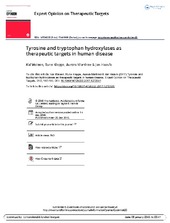| dc.description.abstract | Introduction: The ancient and ubiquitous monoamine signalling molecules serotonin, dopamine, norepinephrine, and epinephrine are involved in multiple physiological functions. The aromatic amino acid hydroxylases tyrosine hydroxylase (TH), tryptophan hydroxylase 1 (TPH1), and tryptophan hydroxylase 2 (TPH2) catalyse the rate-limiting steps in the biosynthesis of these monoamines. Genetic variants of TH, TPH1, and TPH2 genes are associated with neuropsychiatric disorders. The interest in these enzymes as therapeutic targets is increasing as new roles of these monoamines have been discovered, not only in brain function and disease, but also in development, cardiovascular function, energy and bone homeostasis, gastrointestinal motility, hemostasis, and liver function. Areas covered: Physiological roles of TH, TPH1, and TPH2. Enzyme structures, catalytic and regulatory mechanisms, animal models, and associated diseases. Interactions with inhibitors, pharmacological chaperones, and regulatory proteins relevant for drug development. Expert opinion: Established inhibitors of these enzymes mainly target their amino acid substrate binding site, while tetrahydrobiopterin analogues, iron chelators, and allosteric ligands are less studied. New insights into monoamine biology and 3D-structural information and new computational/experimental tools have triggered the development of a new generation of more selective inhibitors and pharmacological chaperones. The enzyme complexes with their regulatory 14–3–3 proteins are also emerging as therapeutic targets. | en_US |

